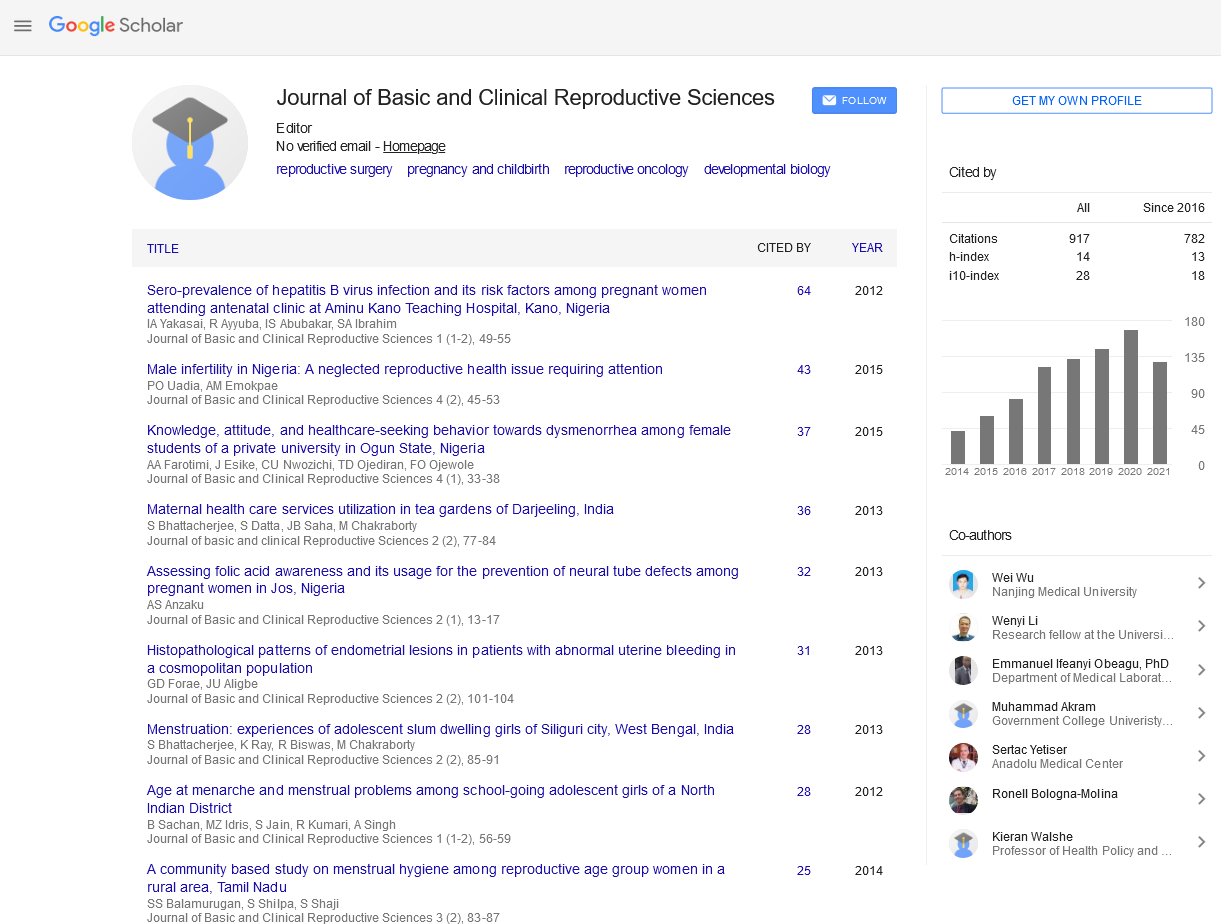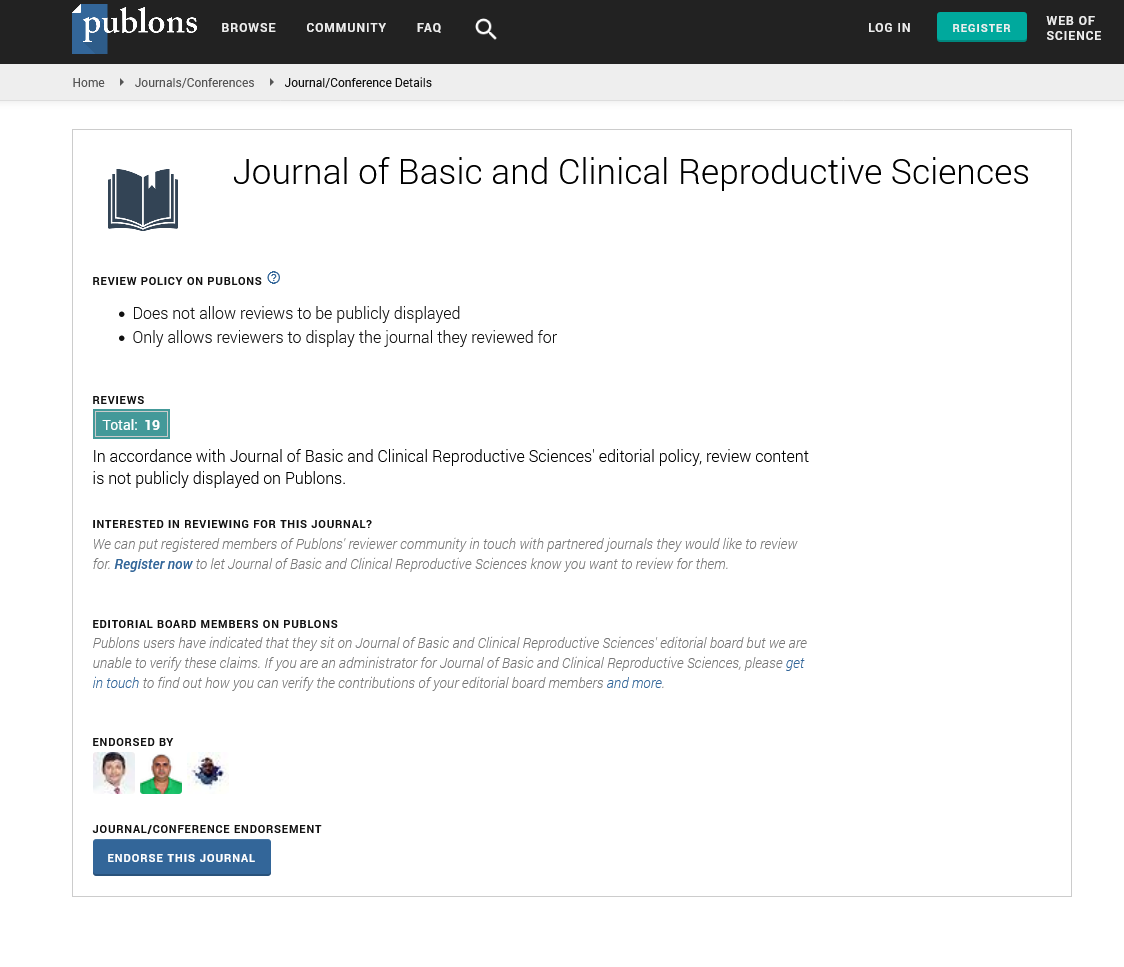Short communication - Journal of Basic and Clinical Reproductive Sciences (2021) Volume 10, Issue 3
Assessing characteristics which influence the success rate of in vitro fertilization
Received: 15-Mar-2021 Accepted Date: Mar 22, 2021 ; Published: 29-Mar-2021
This open-access article is distributed under the terms of the Creative Commons Attribution Non-Commercial License (CC BY-NC) (http://creativecommons.org/licenses/by-nc/4.0/), which permits reuse, distribution and reproduction of the article, provided that the original work is properly cited and the reuse is restricted to noncommercial purposes. For commercial reuse, contact reprints@pulsus.com
Abstract
There are numerous reasons for seeking IVF treatment such as low ovarian reserve, male factors, endometriosis, tubal factors, same sex relationships and ovulation disorders. This audit aims to assess how IVF success rates are affected by various factors including age, BMI, diagnosis, stimulation regime for ovarian stimulation and the type of luteal phase support used. Luteal phase support involves the administration of medication(s) to increase the rates of successful implantation following embryogenesis.
Introduction
Background: There are numerous reasons for seeking IVF treatment such as low ovarian reserve, male factors, endometriosis, tubal factors, same sex relationships and ovulation disorders. This audit aims to assess how IVF success rates are affected by various factors including age, BMI, diagnosis, stimulation regime for ovarian stimulation and the type of luteal phase support used. Luteal phase support involves the administration of medication(s) to increase the rates of successful implantation following embryogenesis.
Aims:
* Determine the overall clinical pregnancy rate for IVF/ICSI cycles with fresh and frozen embryo transfer in 2018 at JCUH.
* Identify causes of infertility and their impact on clinical rates.
* Determine whether the luteal phase support prescribed at JCUH is in keeping of that set out by NICE1 and how they affect pregnancy rates.
Methods: This is a retrospective audit of patients who received IVF/ICSI treatment at the Department of Reproductive Medicine (DRM), James Cook University Hospital (JCUH) from 1/1/2018-31/12/2018. 373 cycles (323 fresh cycles and 50 frozen cycles) took place over that period. Patient data (Age of patient, female patient’s BMI, Anti-Mullerian hormone level, follicular stimulating hormone level, reasons for subfertility, type of stimulation regime for ovarian stimulation) was retrieved from the DRM electronic database and medical notes. The inclusion criteria were all fresh and frozen embryo transfers. All IVF/ICSI treatment cycles which were done for reasons other than to achieve pregnancy or which included donor egg were excluded from the audit.
Summary of Results: The overall clinical pregnancy rate for 2018 was 43.05%. The clinical pregnancy rate per embryo transferred for the fresh cycle at JCUH was higher at 31.6%, compared to the national average of 21%2. In accordance with HFEA, frozen cycles had better outcomes than fresh cycles (34.4% vs 31.6% per embryo transfer). Whether patients were given GnRH agonists or GnRH antagonists for ovarian stimulation, the clinical pregnancy rates were roughly the same (GnRH against: 46.8%; GnRH antagonist: 46.7%). The clinical pregnancy rate for patients who received only progesterone pessaries as luteal phase support was lower at 43.2% compared to 48.6% for those who had both progesterone pessaries and injectable progesterone. Patients receiving steroids as luteal phase support had a high clinical pregnancy rate of 50%.
Conclusion:
* The characteristics that increased success rates were younger age (<35), ↑AMH (>5.4 ), BMI (19-30).
* The two types of stimulation regime for the fresh cycles have similar clinical pregnancy rate. However, the GnRH antagonist protocols are used mainly for poor responder and low ovarian reserve and it is shown in this audit that it improves the pregnancy rate for these patients.
* Causes of subfertility such as male factor, tubal factor, unexplained fertility, structural abnormalities of uterine cavity can be effectively treated to achieve conception.
* Additional progesterone should be considered in poor responder and those needing repeat ovarian stimulation as it improves the pregnancy rate.
* Steroids should be considered in those with recurrent miscarriage or immune factors.
* HCG use only improves the clinical pregnancy rate slightly and is associated with risk of ovarian hyperstimulation syndrome (OHSS). Therefore, its use should be reserved only for selected patients
Biography: Zahirah Nurmeen Nahaboo Solim is currently working on student selected projects related to sterilization procedure and IVF treatment. She has recently won an award from the Royal College of Obstetricians and Gynaecologists related to her project about helping women in need.


